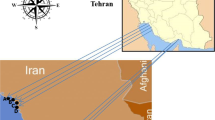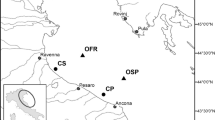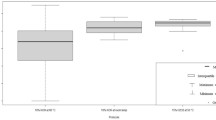Abstract
Microplastics have been considered to be dangerous for aquatic organisms’ health (Alomar et al. 2017). Indeed, their accumulation by ingestion can lead to increased exposure to pollutants and pathogens, and effects on physiological activities linked to nutrient uptake, growth and survival (Browne et al. 2011; Sussarellu et al. 2016; Fendall and Sewell; 2009; Van Cauwenberghe and Janssen; 2014). Von Moos et al. (2012) studied the effect of exposure and ingestion of microplastics (≤80 μm) in Blue mussel (Mytilus edulis, Linnaeus 1758).
Access provided by Autonomous University of Puebla. Download conference paper PDF
Similar content being viewed by others
1 Introduction
Microplastics have been considered to be dangerous for aquatic organisms’ health (Alomar et al. 2017). Indeed, their accumulation by ingestion can lead to increased exposure to pollutants and pathogens, and effects on physiological activities linked to nutrient uptake, growth and survival (Browne et al. 2011; Sussarellu et al. 2016; Fendall and Sewell; 2009; Van Cauwenberghe and Janssen; 2014). Von Moos et al. (2012) studied the effect of exposure and ingestion of microplastics (≤80 μm) in Blue mussel (Mytilus edulis, Linnaeus, 1758). These authors reported that the smallest particle sizes were accumulated in gills and digestive gland with a consequent strong inflammatory response and a lysosomal membrane destabilization. Unfortunately, no information on excretion was provided by these authors and conclusions on the fate of the larger particles cannot be made. Van Cauwenberghe and Janessen (2014), investigated the presence of different microplastics particles (size class 5–10, 11–15, 16–20, 21–25, >25 μm) in farmed blue mussel and Pacific oyster, showing that these were present in both species at concentration of 0.36 ± 0.07 particles g−1 and 0.47 ± 0.16 particles g−1 soft tissue, respectively. The same authors also depurated animals from the same batches for 72 h observing a significant reduction in the abundance of microplastics, concluding that although depuration was an effective procedure, the consumption of farmed bivalves could potentially represent a risk to consumers’ health.
The first aim of this present study was to investigate the adult oysters’ egestion dynamics after exposure to known concentration of microplastics under controlled conditions. Moreover, previous studies have so far used microplastics of sizes comparable to phytoplankton cells. However, in the marine environment, microplastics are present in sizes often larger than microalgae cells and there are evidence suggesting that bivalves could potentially up-take particles as large as 500 μm (O’Donohe and McDeromtt 2014). Still, no information on the ability of oysters to uptake, retain and egest larger particles is currently available. Consequently, the second aim of this study was to determine whether larger particles had the potential to remain in the marketable product post depuration by employing sizes larger than those commonly used in previous microplastics absorption studies. The size classes of 100 ± 7.42, 250 ± 23.2 and 500 ± 52,34 μm were chosen because Van Cauwenberghe and Janssen (2014), found that Crassostrea gigas reared in the Atlantic Ocean (average shell length of 9.0 ± 5.0 cm), showed a prevalence of microplastics size >25 μm, and because studies on mussels and Pacific oysters so far were focused only on microplastics of a size comparable to phytoplankton or in general at size between 0.5 and 90 μm (Sussarellu et al. 2016; Cole and Galloway 2015; Van Cauwenberghe et al. 2015; Farrell and Nelson 2013; Browne et al. 2008; Von Moos et al. 2012), without taking in to account that in the marine environment microplastics are present in different sizes and adults’ Pacific oysters can uptake larger size microplastics from the environment.
2 Materials and Methods
Pacific oysters (20 oysters 85 ± 2.3 g/ind.) were collected from a farm in the San Teodoro Lagoon (Italy) (40°48’39.18’’N, 9°40’24.42’’E), and kept in a cold box until arrival to the laboratory. For the purpose of this study, oysters were individually deployed in 20 glass spherical aquariums of 1.5 L, filled with filtered sea water. Preliminary trials were performed to determine both the level of aeration required and the most suitable type of microplastics polymer. For this purpose, three polymers of the following densities were tested: polystyrene 1.04–1.1 g/cm3; polyamide 1.12–1.15 g/cm3; polycarbonate 1.20–1.22 g/cm3 (Avio et al. 2016; Enders et al. 2015). With the aim to keep the microplastics beads suspended in the water column to maximise their chances to be filtered by the oysters, batches of 30 microplastics per polymer were deployed to an experimental tank and aeration was adjusted by a valve. Once the appropriate aeration was identified by observing the microplastics distribution on the water column, the ability of the chosen polymer to withstand the tissue digestion procedure (Li et al. 2015) was tested. This was conducted using a sterile container containing soft tissues of 3 Pacific oysters (80 ± 3.5 g/ind.) plus 9 plastic beads per size class (100 ± 7.42, 250 ± 23.2 and 500 ± 52,34 μm) of the microplastics chosen for the study (3 replicates). The soft tissue was covered with hydrogen peroxide 15%, this was added until the oyster was completely digested (Avio et al. 2016). Once the oysters were digested the remaining solution was filtered using 47 mm Whatman GF/F filters (0.6–0.8 μm) and then analysed under the dissecting microscope (Leica Mz8).
The experiment was carried out in 2 parts: 24 h exposure (Cole and Galloway 2015) and 72 h depuration (Van Cauwenberghe and Janessen 2014). During the first 24 h experimental individuals (n = 20) were individually exposed to 30 microplastic particles of each size (100, 250 and 500 μm) with a density of 60 particles per litre. This particles density despite being higher than the ones commonly reported in sea water (De Lucia et al. 2014) was chosen for analytical and practical reasons. The oysters collected after exposure were transferred to a new tank, again filled with 1.5 L of filtered sea water. Aeration was not supplied in order to avoid faeces and pseudo-faeces mixing. The water left in the tanks during the 24, 48 and 72 h after exposition, was filtered and beads counted using the same procedure described above. Finally, at the end of the trial (72 h after exposure) oysters were collected from the experimental tanks and externally washed and dissected taking care that the water contained in the shell cavity was stored in a plastic tray. The digestive gland, gills and mantle of each oyster were dissected, washed and placed in labelled sterile containers. The water contained in the shell and the water used to wash the tissues was collected and filtered as described previously. All dissected tissues of each individual were digested using hydrogen peroxide 15%, at room temperature of 22 °C for 7 days, and the resulting digestate was filtered.
3 Results and Discussion
3.1 Results
At the end of the 24 h exposure, the uptake (% of missing beads) of the different sizes (100, 250 and 500 μm), was 19.4 ± 1.1%, 19.4 ± 2% and 12.9 ± 2% respectively. No significant difference in uptake between the microplastics of 100 and 250 μm was observed, however beads of 500 μm in size had a significant lower uptake when compared with the others sizes (P = 0.009) (Fig. 1).
Table 1 illustrates the percentage of microplastics recovered from the depuration water, and tissues at the different time points over the depuration period. A significant effect of time (p < 0.001) and a significant interaction between time and treatment (p < 0.02) was observed. The excretion of microplastics beads of all sizes was significantly higher during the first 24 h in comparison with the later time points. Furthermore, no significant difference was recorded in the excretion of microplastic particles of 100 μm and 500 μm between 48 and 72 h of depuration, whilst significantly more beads of 250 were released after 48 h in comparison to 72 h of exposure (Fig. 2).
Although the vast majority of ingested microplastic particles were released during the 72 h of depuration, 17.7 ± 3.8, 16.7 ± 2.4 and 5.4 ± 2.7% of microplastic particles of 100, 250 and 500 μm respectively were still present in the water contained inside the shell cavity. At this location a significant difference in the abundance of each particle size class was observed, with the largest size class being significantly less abundant than the other two (p = 0.007) (Fig. 3). Importantly, no microplastic particles were found in the digestive gland and in the other tissues post digestion. Taking into account each time step there was a decreasing egestion of microplastic particles during the depuration time: 63.9 ± 3%, 17 ± 2.2% and 3.7 ± 0.9% in 24, 48 and 72 h, respectively. Only 15.4 ± 2% of the microplastic particles were retained within the oysters after 72 h of depuration (Table 1).
3.2 Discussion
In this study, Pacific oysters showed an efficient egestion rate, egesting 84.6 ± 2% of the microplastic particles taken up, while only the 15.4 ± 2% of beads taken up were retained within the shell cavity, post depuration. Furthermore, no microplastic particles were observed within the oysters’ tissues, while in the Sussarellu et al. (2016) study, microplastic particles were found in the stomach and the intestine of Pacific oysters. This can be attributed to the difference in the particle size used (100, 250 and 500 vs 2–6 μm), and it is possible that the C. gigas food sorting mechanisms recognise only the smaller size as a food source due to similarity in size with phytoplankton (Ward and Shumway 2004).
4 Conclusions
To date, studies on microplastic uptake have been conducted mainly to investigate their potential negative physiological effects on marine live, including bivalves, or to establish whether animals entering the human food chain could be a carrier of these particles and therefore represent a risk for consumers (Sussarellu et al. 2016; Fernández et al. 2018; Von Moos et al. 2012; Pont et al. 2016; Silva et al. 2016; Van Cauwenberghe and Janessen 2014). The main difference between these approaches has been the controlled nature of the studies. The former employed controlled conditions (known density, type and size of the microplastics employed), whilst the latter focused on the abundance of plastics in marketable products without considering levels of exposure, uptake or the nature of the polymers. In contrast, our study investigated both the uptake and egestion dynamics under controlled conditions to more robustly describe the fate of microplastic particles of 100 to 500 μm diameters during exposure and depuration therefore contributing to the collective knowledge on these dynamics in shellfish produced for human consumption. Our results suggest that these larger particles could probably be filtered by the oysters but, instead of being ingested, they are retained within the shell cavity by adhesion. Importantly, during the depuration period, microplastic particles were observed in faeces and pseudo-faeces, but it is not possible to conclude here that the beads have been ingested, because these were not observed within the digestive system. Further work focused on the ingestion and excretion of microplastic particles of different sizes class, including particles larger than microalgae cells, should be conducted to estimate gut transit time of these particles. In conclusion our data, taken together with results from other studies, strongly indicate that M. gigas could be a carrier of different microplastic sizes in the human food chain, not only through the absorption and inclusion in tissues (Bricker et al. 2014; Van Cauwenberghe and Janessen 2014; Li et al. 2015), but also through the adhesion of these particles in different parts of the internal cavity of the oysters shell.
References
Alomar, C., Sureda, A., Capó, X., Guijarro, B., Tejada, S., Deudero, S.: Microplastic ingestion by Mullus surmuletus Linnaeus, 1758 fish and its potential for causing oxidative stress. Environ. Res. 159, 135–142 (2017)
Avio, C.G., Gorbi, S., Regoli, F.: Plastics and Microplastics in the oceans: from emerging pollutants to emerged threat. Mar. Environ. Res. 128, 2–11 (2016)
Bricker, S., Lauenstein, G., Maruya, K.: NOAA’s mussel watch program: incorporating contaminants of emerging concern (CECs) into a long-term monitoring program. Mar. Pollut. Bull. 81, 289–290 (2014)
Browne, M.A., Dissanayake, A., Galloway, T.S., Lowe, D.M., Thompson, R.C.: Ingested microscopic plastic translocates to the circulatory system of the mussel. Mytilus edulis (L) Environ. Sci. Tech. 42 (13), 5026–5031 (2008)
Browne, M.A., Crump, P., Niven, S.J., Teuten, E., Tonkin, A., Galloway, T., Thompson, R.: Accumulation of microplastics on shorelines worldwide: sources and sinks. Environ. Sci. Technol. 45(21), 9175–9179 (2011)
Cole, M., Galloway, T.S.: Ingestion of nanoplastics and microplastics by Pacific Oyster Larvae. Environ. Sci. Technol. 49(24), 14625–14632 (2015)
De Lucia, G.A., Caliani, I., Marra, S., Camedda, A., Coppa, S., Alcaro, L., Campani, T., Giannetti, M., Coppoa, D., Cicero, A.M., Panti, C., Baini, M., Guerranti, C., Marsili, L., Massaro, G., Fossi, M.C., Matiddi, M.: Amount and distribution of neustonic micro-plastic off the western Sardinian coast (Central-Western Mediterranean Sea). Mar. Environ. Res. 100, 10–16 (2014)
Enders, K., Lenz, R., Stedmon, C.A., Nielsen, T.G.: Abundance, size and polymer composition of marine Microplastics ≥ 10 µm in the Atlantic Ocean and their modelled vertical distribution. Mar. Pollut. Bull. 100(1), 70–81 (2015)
Farrel, P., Nelson, K.: Trophic level transfer of microplastics: Mytilus edulis (L.) to Carcinus maenas (L.). Enviromen. Pollut. 177, 1–3 (2013)
Fendall, L.S., Sewell, M.A.: Contributing to marine pollution by washing your face: microplastics in facial cleaners. Mar. Pollut. Bull. 58(8), 1225–1228 (2009)
Fernández, C.G., Tallec, K., Le Goic, N., Lambert, C., Soudant, P., Huvet, A., Suquet, M., Berchel, M., Pont, I.P.: Cellular responses of Pacific oyster (Crassostrea gigas) gametes exposed in vitro to polystyrene nanoparticles. Chemosphere 208, 764–772 (2018)
Li, J., Yang, D., Li, L., Jabeen, K., Shi, H.: Microplastics in commercial bivalves from China. Environ. Pollut. 207, 190–195 (2015)
O’Donohe, P., McDermott, T.: Reducing sea lice re-infestation risk from harvest water at a salmon farm site in Irleand using a bespoke sieving and filtration system. Aquacult. Eng. 60, 73–76 (2014)
Pont, I.P., Lacroix, C., Fernández, C.G., Hégaret, H., Lambert, C., Le Goïc, N., Frère, L., Cassone, A.L., Sussarellu, R., Fabioux, C., Guyomarch, J., Albentosa, M., Huvet, A., Soudant, P.: Exposure of marine mussels Mytilus spp. To polystyrene microplastics: toxicity and influence on fluoranthene bioaccumulation. Environ. Pollut. 216, 724–737 (2016)
Silva, P.P.G., Nobre, C.R., Resaffe, P., Pereira, C.D.S., Gusmão, F.: Leachate from microplastics impairs larval development in brown mussels. Water Res. 106, 364–370 (2016)
Sussarellu, R., Suquet, M., Thomas, T., Lambert, C., Fabioux, C., Pernet, M.E.J., Le Goic, N., Quillien, V., Mingant, C., Epelboin, Y., Corporeau, C., Guyomarch, J., Robbens, J., Pont, I.P., Soudant, P., Huvet, A.: Oyster reproduction is affected by exposure to polystyrene microplastics. PNAS 113(9), 2430–2435 (2016)
Van Cauwenberghe, L., Janssen, C.R.: Microplastics in bivalves cultured for human consumption. Environ. Pollut. 193, 65–70 (2014)
Van Cauwenberghe, L., Claessens, M., Vandegehuchte, M.B., Janssen, C.R.: Microplastics are taken up by mussels (Mytilus edulis) and lugworms (Arenicola marina) living in natural habitats. Environ. Pollut. 199, 10–17 (2015)
Von Moos, N., Burkhardt, H.P., Kohler, A.: Uptake and effects of Microplastics on cells and tissue of the blue mussel Mytilus edulis L. after experimental exposure. Environ. Sci. Technol. 46, 11327–11335 (2012)
Ward, J.E., Shumway, S.E.: Separating the grain from the chaff: particle selection in suspension-and deposit-feeding bivalves. J. Exp. Mar. Biol. Ecol. 300(1–2), 83–130 (2004)
Author information
Authors and Affiliations
Corresponding author
Editor information
Editors and Affiliations
Rights and permissions
Copyright information
© 2020 Springer Nature Switzerland AG
About this paper
Cite this paper
Graham, P., Palazzo, L., Carboni, S., Telfer, T., Baroli, M., de Lucia, G.A. (2020). Microplastics Uptake and Egestion Dynamics in Pacific Oysters, Magallana Gigas (Thunberg, 1793), Under Controlled Conditions. In: Cocca, M., et al. Proceedings of the 2nd International Conference on Microplastic Pollution in the Mediterranean Sea. ICMPMS 2019. Springer Water. Springer, Cham. https://doi.org/10.1007/978-3-030-45909-3_32
Download citation
DOI: https://doi.org/10.1007/978-3-030-45909-3_32
Published:
Publisher Name: Springer, Cham
Print ISBN: 978-3-030-45908-6
Online ISBN: 978-3-030-45909-3
eBook Packages: Earth and Environmental ScienceEarth and Environmental Science (R0)







